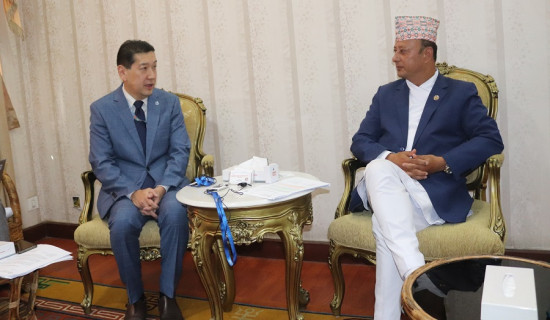- Wednesday, 20 November 2024
Inflation goes down to 3.85% as current account records surplus of Rs. 112 billion
By A Staff Reporter,Kathmandu, Nov. 20: The growth rate of remittance inflow into Nepal has moderated both on year-on-year and monthly basis.
Remittance inflows increased by 11.5 per cent to Rs. 407.31 billion in the first four months of the current Fiscal Year 2024/25 compared to an increase of 25.8 per cent in the same period of the last year 2023/24, according to the Nepal Rastra Bank's 'Current macroeconomic and financial situation' report published on Tuesday.
Similarly, remittance inflow increased by 15.2 per cent reaching Rs. 263.14 billion in the first three months by mid-October. In the same period of 2023/24, the country received Rs. 228.40 billion in remittance.
However, in terms of amount, there has been a significant increase in the inflow with remittance reaching US$ 3.04 billion in the four months which was US$ 2.76 billion in the same period of the previous year.
The report mentioned that the net transfer from abroad to Nepal reached Rs. 442.44 billion during the first four months of this year compared to Rs. 404.07 billion in the same period of the previous year.
The number of Nepali workers, both institutional and individual, taking first-time approval for foreign employment stands at 110,654 and taking approval for renew entry stands at 59,939. In 2023/24, such numbers were 113,397 and 49,297 respectively.
Current account surplus reaches Rs. 111.8 billion
Similarly, the current account of the country remained at a surplus of Rs. 111.87 billion in mid-July to mid-November this year compared to a surplus of Rs.59.65 billion in the same period of last year, stated the report.
Net capital transfer amounted to Rs. 2 billion and foreign direct investment inflow (Equity only) remained at Rs. 4.81 billion. Last year, net capital transfer had amounted to Rs.1.15 billion and foreign direct investment inflows (Equity only) amounted to Rs.3.38 billion.
Likewise, Balance of Payments (BOP) remained at a surplus of Rs. 184.99 billion in the review period compared to a surplus of Rs. 101.66 billion in the same period of the previous year. Gross foreign exchange reserves increased by 9.4 per cent to Rs. 2232.28 billion in mid-October 2024 from Rs. 2041.10 billion in mid-July 2024.
"Of the total foreign exchange reserves, reserves held by NRB increased by 7.5 per cent to Rs. 1988 billion in mid-October 2024 from Rs. 1848.55 billion in mid-July 2024. Reserves held by banks and financial institutions (except NRB) increased by 26.9 per cent to Rs. 244.27 billion in mid-October 2024 from Rs. 192.55 billion in mid-July 2024," read the report. The share of Indian currency in total reserves stood at 21.9 per cent.
Likewise, based on the imports of three months of 2024/25, the foreign exchange reserves of the banking sector is sufficient to cover the prospective merchandise imports of 17.6 months, and merchandise and services imports of 14.6 months.
Inflation goes further down
The y-o-y consumer price inflation stood at 4.82 per cent in mid-October 2024 compared to 7.50 per cent a year ago. Inflation rate dropped to 4.10 per cent in mid-August this year, and 3.85 per cent in mid-September.
The NRB report stated that food and beverage inflation stood at 7.18 per cent whereas non-food and service inflation stood at 3.49 per cent in the review period. During the same period in the previous year, the price indices of these groups had increased by 8.48 per cent and 6.85 per cent respectively.
The year-on-year price index of vegetables increased by 25.15 per cent, pulses and legumes by 10 per cent, cereal grains and their products by 9.57 per cent, and ghee and oil by 4.98 per cent while price index of meat and fish decreased by 1.18 per cent and spices by 0.79 per cent.
Similarly, y-o-y price index of miscellaneous goods and services sub-category increased by 10.49 per cent, alcoholic drinks by 6.32 per cent, clothes and footwear by 6.12 per cent and furnishing and household equipment by 4.88 per cent. Inflation was high in rural areas with price index increasing by 5 per cent on year-on-year basis while it went up by 4.76 per cent in urban areas.















